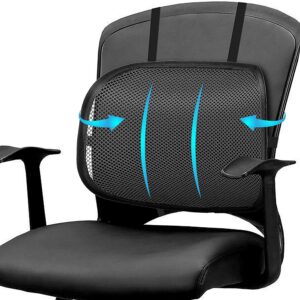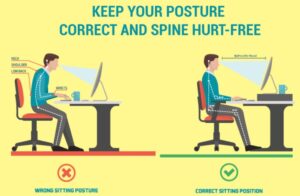A comfortable workspace can help improve your productivity. If you sit behind your desk for long hours during work, the wrong sitting position may cause some adverse effects like neck pains, tension at the knees, back, and poor circulation.
It’s vital to have an office chair that ergonomically supports your lower back to promote great posture to avoid these problems. Here are various preventive steps that you can use to ensure that you are comfortable, safe, and productive at your workspace.

Ways to Adjust Your Sitting Position
1. Support Your Back
It will help to adopt a position that supports the natural curve of the spine while efficiently supporting the lumbar region. Sit with the upper back straight, and the lower part curved to the chair’s shape.
Press your back and buttocks to the farthest end of the chair to achieve a straight posture, angling to or past 90 degrees. If you must lean forward to use the computer, move your seat closer to the desk. In some chairs, you can also adjust the band for extra lower back support. This posture will help reduce spinal stress and back pains.

2. Adjust The Chair
Balance the chair’s height so that your knees remain in line with the hips and the feet flat on the floor. Also, adjust the seat to facilitate comfortable sit to stand movements. If you position the chair too low, you are more likely to bend your upper body while standing. As a result, it may stress the ankle, knees, and hips, causing joint pains. Moreover, ensure enough space between the chair edge and the knee’s back to rest the legs in a more relaxed position.
An ergonomic office chair allows you to adjust the angle horizontally to provide a comfortable sitting position that maintains a great posture. You can opt for a slight inclination in a forward position towards the workplace that relieves pressure under your thigh, giving you a more open hip angle for a better back posture.

3. Align Your Arms To The Spine
While sitting in your chair, keep your arms parallel to the spine. Further, rest your hand and forearm to the workstation comfortably. Place the elbows by the side and extend the arm to form an L-shaped bend at an angle of 90 degrees. To achieve this, you might have to adjust the armrest higher or lower based on your height.
Avoid placing your arms in the wrong position since it strains your shoulders, joints, and upper back. Further, keep frequently used items within reach. Forcing your arm beyond the safe distance range for comfort and movement while trying to get essential items could strain your arm, neck, and back. Stand up to get anything that you can’t comfortably grab while seated.

4. Keep Your Head Balanced
Most people tend to tilt the head towards the screen, which strains the spine and neck over time. Keep your eyes level to prevent hanging your head, which can also weaken the spinal cord. You may also need to adjust the workstation and position your computers about an arm’s length away from your body to achieve this.
Sit on the chair and face forward with your eyes closed, then open them aimed at the center of the screen, and adjust it to your gaze’s level. Keeping your head balanced also maintains the neck in a relaxed position.
5. Provide Sufficient Support For Your Feet
Adjust your chair’s height so you can rest your feet on a flat surface. You can also add a footstool to support your feet instead of leaving them hanging all day long. It will help reduce the pressure on the foot to avoid pain.
Watch out for any mess underneath the workspace that can limit your legs movement and impede blood circulation. Avoid crossing your legs while seated since it may result in an uncomfortable tingling feel.
Instead, ensure that you distribute your body weight evenly across the hips. You achieve this by bending the knees at a right angle, in an even or slightly lower position than the hips. With both feet on the floor, it helps balance your pelvis, making it easier to arch the lower back.
- FOR THE BEST SUPPORT POSSIBLE, your under desk foot rest should be CUSTOMIZABLE to your needs – but many foot stools are THE WRONG HEIGHT and AREN’T ADJUSTABLE. Made by the only foot rest brand endorsed by U.S. chiropractors, the ErgoFoam Adjustable Foot Rest ADJUSTS EASILY to the optimum height for your chair & leg length, providing the support you need for LONG-LASTING COMFORT, BETTER POSTURE, and RELIEF FROM LUMBAR, BACK, and LEG PAIN.
- THE AVERAGE OFFICE FOOT REST is great for the first fifteen minutes, but then starts to FLATTEN OUT due to LOW-QUALITY FOAM that’s too soft and flimsy. Our high-density ErgoFoam was developed to MAINTAIN ITS SHAPE and FIRMNESS over time, RESISTING COMPRESSION under the weight of your legs and feet – and providing better support than memory foam foot rest s. With a DOUBLE-SIDED NONSLIP BOTTOM, this under desk foot stool stays put and won’t slide around on your floor.
- 2 FOOT RESTS IN 1! Larger and wider than other foot rest stools, our ergonomic foot rest under desk design features an ARCHED STRUCTURE for COMFY SUPPORT throughout the day. WANT TO GET YOUR FEET & LEGS MOVING? Flip over your foot pillow to transform it into a ROCKER FOOT REST for increased circulation and muscle movement. With our foot stool under desk cushion, you’ll notice IMPROVED POSTURE and less back, hip & leg pain. To clean, simply remove its velvet cover and TOSS IT IN THE WASH.
- OUR PROMISE TO YOU: We developed our adjustable foot rest for under desk to be THE ABSOLUTE BEST FOOT CUSHION on the market, providing UNPARALLELED FOOT SUPPORT, better posture & circulation, and REDUCED PAIN and PRESSURE on the legs, back, and spine. If for any reason you aren’t satisfied with your office foot rest under desk pillow, WE’RE STANDING BY TO HELP make it right – no questions asked. WE MAKE OUR CUSTOMERS OUR VERY TOP PRIORITY.
- AT ERGOFOAM, OUR GOAL IS TO HELP YOU FEEL YOUR BEST, EVERY DAY. We designed our line of home office accessories and work from home essentials to bring you COMFORT & EASE IN ANY ENVIRONMENT, whether you’re working at your desk or relaxing on the couch. The perfect combination of UNBEATABLE SUPPORT and DURABLE CONSTRUCTION, you’ll want to bring your ergonomic office footrests with you wherever you go.
6. Measure The Depth Of Your Seat
Although highly ignored, the correct chair depth will help eliminate back pain. It’s merely the length between the back and front edge of the seat. The chair should have enough width to support you comfortably so that you sit with your back against the backrest and leave about 2 to 4 inches between your knees and back of the seat. The right depth allows adjustable forward and backward tilt and gives you enough space for blood circulation.
7. Reevaluate The Sitting Posture
To efficiently support your posture, keep pulling back if you slouch, which can exert extra pressure on your lower back. You also need to adjust your chair’s swivel and recline positions to prevent it from tipping back. Further, avoid placing your legs on the casters while working since it cranes your body forward, and you adopt the wrong posture.
Besides, center your activities with your body by placing the keyboards between shoulders. You may need to change the workstation to match your height, which also helps you adopt a more suitable chair height to avoid back pains.
Keep in mind that the correct sitting position isn’t limited to a particular posture, and you can switch poses as often as possible.

8. Take Brief Breaks And Practice Posture Exercises
Get up, walk, and stretch in between work hours to increase blood flow and reenergize your body. It’s worth noting that several short stretches work better than fewer and long ones. In addition to the few breaks, you can try out a few exercises to relax your muscles.
After work, a 60 minutes’ walk will help counter the effects of prolonged sitting. Besides, yoga poses encourage muscle stretching and alignment to allow you to sit straighter at your desk with fewer discomforts.

Conclusion
Sitting for a very long period in the wrong posture affects your health. With the above tips on how to sit in an ergonomic office chair, you should be in a position to synchronize your seat and work station to reduce unwanted stress on your joints and spine. It might feel like a lot of work to maintain a great posture, but you will feel the difference with time.


